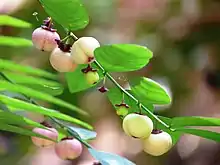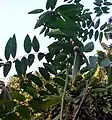| Sauropus androgynus | |
|---|---|
 | |
| Scientific classification | |
| Kingdom: | Plantae |
| Clade: | Tracheophytes |
| Clade: | Angiosperms |
| Clade: | Eudicots |
| Clade: | Rosids |
| Order: | Malpighiales |
| Family: | Phyllanthaceae |
| Genus: | Sauropus |
| Species: | S. androgynus |
| Binomial name | |
| Sauropus androgynus | |
| Synonyms[2][3] | |
|
List
| |
Sauropus androgynus, also known as katuk, star gooseberry, or sweet leaf, is a shrub grown in some tropical regions as a leaf vegetable.
Its multiple upright stems can reach 2.5 meters high and bear dark green oval leaves 5–6 cm long.
It is a good source of vitamin K. However, a study has suggested that excessive consumption of juiced Katuk leaves (due to its popularity for body weight control in Taiwan in the mid '90s) can cause lung damage, due to its high concentrations of the alkaloid papaverine.[4]
It also has high level of provitamin A carotenoids, especially in freshly picked leaves, as well as high levels of vitamins B and C, protein and minerals. The more the leaves mature, the higher the nutrient content of the leaves.[5]
It is common in evergreen forest and cultivated up to 1,300 m.[6]
Cultural usage
It is one of the most popular leafy vegetables in South and Southeast Asia and is notable for high yields and palatability.[7]
Indonesia
In Indonesia, the flowers, leaves, and small purplish fruits of Sauropus androgynus has been consumed and used traditionally since ancient times by the Javanese and Sundanese ethnic groups as the alternative medicine in a form of Jamu (traditional concoction native to Java island, originally formulated by the Javanese) to improve the circulation of blocked breast milk for breastfeeding mothers.[8] Interestingly, according to modern research findings on the efficacy of this herb, indicates that the extract of the Sauropus androgynus leaf increases the expression of prolactin and oxytocin genes 15 to 25 times in breastfeeding mice.[9]
Malaysia
In Malaysia, it is commonly stir-fried with egg or dried anchovies.
Vietnam
In Vietnam, the shoot tips have been sold in cuisine and used similarly like the asparagus; the locals usually cook it with crab meat, minced pork or dried shrimp to make a soup.
Medical
Consumption of Sauropus androgynus has been reported as being associated with bronchiolitis obliterans.[10] [11]
The leaves are safe to eat in large quantities only after being cooked as heat seems to denature the toxin.[12]
Nutrition
Sauropus is a good source of β-carotene. α- and β-carotenes are partly metabolized into vitamin A. It is rich in Vitamin C, providing more than 288% of the Daily Value (DV) per 100 g serving, and high in iron (23% DV) and zinc (10% DV).[13] However, the high levels of polyphenols inhibit the absorption of iron and zinc.
| Nutritional value per 100 g (3.5 oz) | |
|---|---|
| Energy | 245 kJ (59 kcal) |
11 g | |
1 g | |
4.8 g | |
| Vitamins | Quantity %DV† |
| Vitamin A | 10370 IU |
| Thiamine (B1) | 9% 0.1 mg |
| Vitamin C | 288% 239 mg |
| Minerals | Quantity %DV† |
| Calcium | 20% 204 mg |
| Iron | 23% 3 mg |
| Phosphorus | 14% 98 mg |
| Potassium | 10% 457 mg |
| Sodium | 2% 25 mg |
| Zinc | 10% .94 mg |
| Other constituents | Quantity |
| Water | 91.4 g |
| |
| †Percentages are roughly approximated using US recommendations for adults. | |
 Leaves and fruits Sauropus androgynus
Leaves and fruits Sauropus androgynus Sauropus androgynus
Sauropus androgynus
Vernacular names
- In Chinese, it is called mani cai (马尼菜)
- In Filipino, it is called Chinese malunggay
- In Indonesian, it is called katuk
- In Japanese, it is called amame shiba (アマメシバ)
- In Javanese, it is called kaṭuk (ꦏꦛꦸꦏ꧀)
- In Tamil, it is called Thavasi Keerai (தவசிக்கீரை)
- In Malayalam, it is called Madhura cheera (lit. "the Madura's spinach") or Singapura cheera (lit. "the Singapore's spinach")
- In Sinhalese, it is called Singapore leaves ( සිංගප්පුරු කොල) or Japan Batu (ජපන් බටු)
- In Malay, it is called cekur manis (in Malaysian Malay), or asin-asin and cangkok manis (in Brunei Malay)[14][15]
- In Sundanese, it is called kaṭuk (ᮊᮒᮥᮾ)
- In Thai, it is called pak waan (or pak waan ban; to distinguish it from Melientha suavis, a completely different plant)
- In Vietnamese, it is called rau ngót
References
- ↑ Under its currently accepted name of Sauropus androgynus (from its basionym Clutia androgyna) this species was published in Bulletin of the Bureau of Forestry, Philippine Islands. Manila 1: 30. 1903. "Name – Sauropus androgynus (L.) Merr". Tropicos. Saint Louis, Missouri: Missouri Botanical Garden. Retrieved November 18, 2012.
Basionym: Clutia androgyna L.
- ↑ The basionym of S. androgynus (Clutia androgyna) was originally described and published in Mantissa Plantarum 1: 128. 1767. "Name – Clutia androgyna L." Tropicos. Saint Louis, Missouri: Missouri Botanical Garden. Retrieved November 18, 2012.
- ↑ "TPL, treatment of Sauropus androgynus". The Plant List; Version 1. (published on the internet). Royal Botanic Gardens, Kew and Missouri Botanical Garden. 2010. Retrieved November 18, 2012.
- ↑ Kao CH; Ho YJ; Wu CL; ChangLai SP (1999). "Using 99mTc-DTPA Radioaerosol Inhalation Lung Scintigraphies to Detect the Lung Injury Induced by Consuming Sauropus androgynus Vegetable and Comparison with Conventional Pulmonary Function Tests". Respiration. Karger AG. 66 (1): 46–51. doi:10.1159/000029336. PMID 9973690. S2CID 38378580.
- ↑ 19.1 Sauropus androgynus (sweet leaf bush)
- ↑ "Globinmed – Globinmed". www.globinmed.com.
- ↑ Padmavathi, P.; Rao, M. Prabhakara (April 1990). "Nutritive value ofSauropus androgynus leaves". Plant Foods for Human Nutrition. 40 (2): 107–113. doi:10.1007/BF02193767. PMID 2385571. S2CID 21391484.
- ↑ N., Andarwulan; R., Batari; D. A., Sandrasari; B., Bolling; H., Wijaya (2010). "Flavonoid Content and Antioxidant Activity of Vegetables from Indonesia". Food Chemistry. Europe PMC. 121 (4): 1231–1235. doi:10.1016/j.foodchem.2010.01.033. PMC 5555161.
- ↑ Martha Tilaar, Dr.; Bernard T. Widjaja, MM, Prof. Dr. Ir. (2015). The Tale of Jamu: The Green Gold of Indonesia. Jakarta: Gramedia Pustaka Utama. p. 162. ISBN 9786020322803.
- ↑ Oonakahara, Kenichi; Matsuyama, Wataru; Higashimoto, Ikkou; Machida, Kentarou; Kawabata, Masaharu; Arimura, Kimiyoshi; Osame, Mitsuhiro; Hayashi, Miho; Ogura, Takashi; Imaizumi, Kazuyoshi; Hasegawa, Yoshinori (2005). "Outbreak of Bronchiolitis obliterans Associated with Consumption of Sauropus androgynus in Japan – Alert of Food-Associated Pulmonary Disorders from Japan". Respiration. 72 (2): 221. doi:10.1159/000084058. PMID 15824537. S2CID 34939585.
- ↑ Lai, Ruay-Sheng; Chiang, Ambrose A; Wu, Ming-Ting; Wang, Jyh-Seng; Lai, Nin-Sheng; Lu, Jau-Yeong; Ger, Luo-Ping; Roggli, Victor (1996). "Outbreak of bronchiolitis obliterans associated with consumption of Sauropus androgynus in Taiwan". The Lancet. 348 (9020): 83–85. doi:10.1016/S0140-6736(96)00450-3. PMID 8676721. S2CID 2653113.
- ↑ Kakaes, Konstantin (14 August 2014). "Sayur Manis: Delicious, But Also Deadly, Greens From Borneo". NPR.org. Retrieved 2021-09-22.
- ↑ Nguyen, Khan (2007). Vietnamese Food Composition Table (PDF). Hanoi: Ministry of Health, National Institute of Vietnam. p. 168.
- ↑ Coope, A.E. (1993). Malay-English, English-Malay Dictionary (Rev. ed.). New York: Hippocrene Books. pp. 18, 61. ISBN 0-7818-0103-6.
- ↑ Bangchik (2009-10-08). "Cups in the air. asin-asin". Retrieved 2010-05-18.